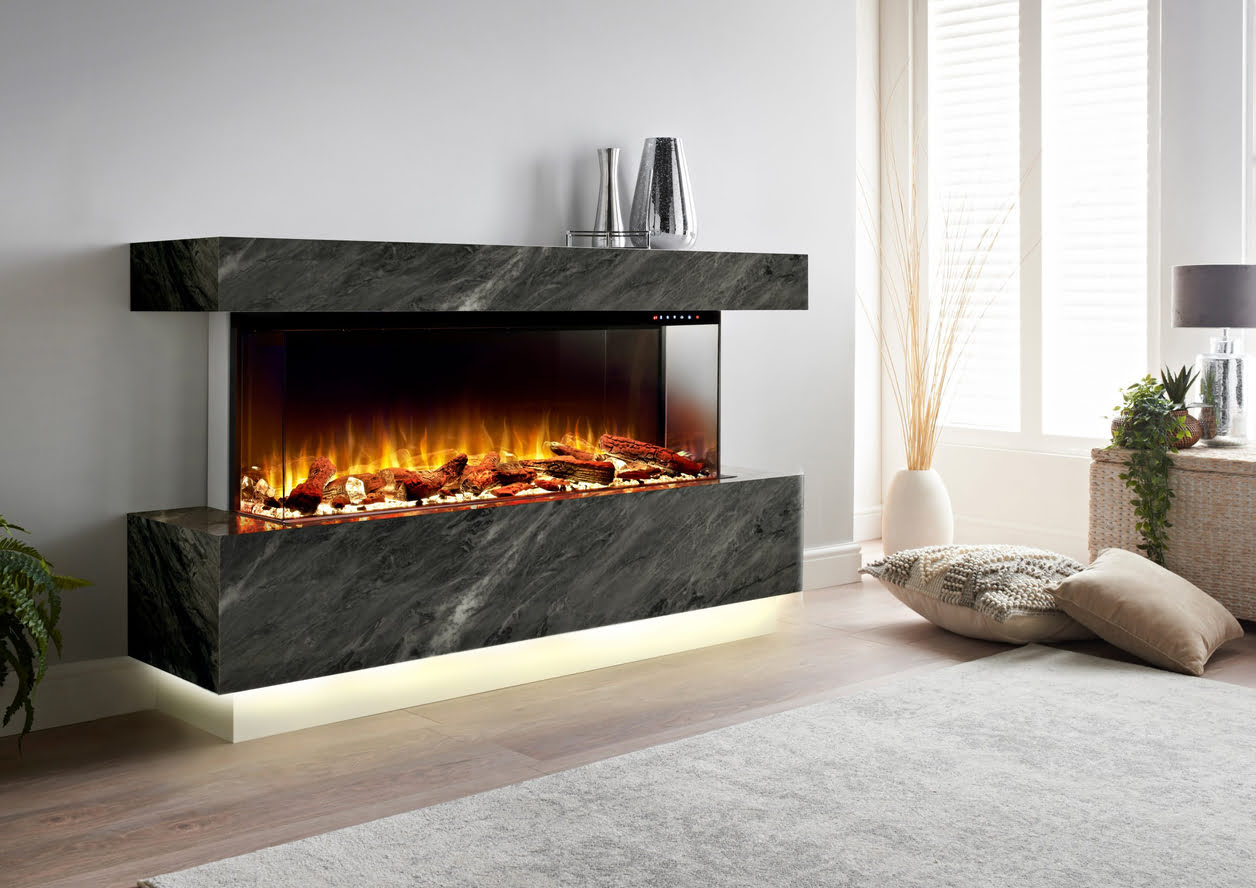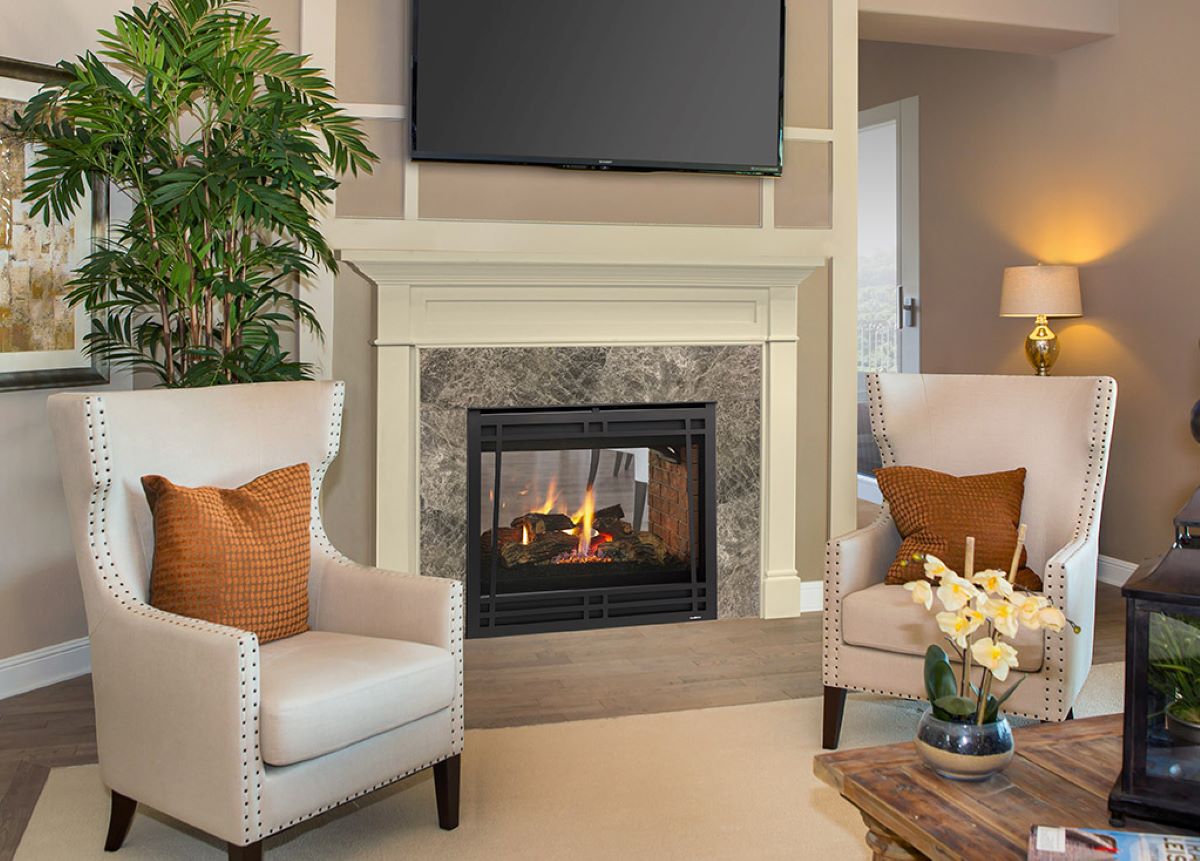

Articles
How To Convert Gas Fireplace To Electric
Modified: January 8, 2024
Discover the step-by-step process of converting a gas fireplace to electric with our informative articles. Enjoy a hassle-free, energy-efficient heating solution in no time!
(Many of the links in this article redirect to a specific reviewed product. Your purchase of these products through affiliate links helps to generate commission for Storables.com, at no extra cost. Learn more)
Introduction
Fireplaces have long been a popular addition to homes, offering both warmth and a cozy ambiance. Traditionally, gas fireplaces have been the go-to option for homeowners. However, in recent years, electric fireplaces have gained popularity due to their convenience, efficiency, and aesthetics. In this article, we will explore the reasons why you might consider converting your gas fireplace to an electric one, as well as the steps involved in the conversion process.
Converting a gas fireplace to electric has become a common home improvement project, as it allows homeowners to enjoy the benefits of an electric fireplace without the hassle and maintenance associated with a gas-powered unit. From energy efficiency to ease of installation, there are several compelling reasons why you may want to make the switch. Let’s delve deeper into these reasons.
Key Takeaways:
- Converting a gas fireplace to electric offers ease of installation, energy efficiency, and versatile design options, providing a hassle-free and customizable heating solution for homeowners.
- Prioritizing safety and following manufacturer’s instructions are crucial when converting a gas fireplace to electric, ensuring a smooth and worry-free transition to a modern and convenient heating alternative.
Read more: How Much To Convert To A Gas Fireplace
Reasons to Convert Gas Fireplace to Electric
Converting a gas fireplace to electric offers numerous benefits that make it an attractive option for homeowners. Here are some reasons why you might consider making the switch:
- Ease of Installation: Electric fireplaces are relatively easy to install compared to gas fireplaces. They don’t require a vent or chimney, eliminating the need for complex ductwork or professional installation. This means you can convert your gas fireplace to electric with minimal hassle and without the need for major renovations.
- Energy Efficiency: Electric fireplaces are highly energy-efficient, as they convert all of the energy they consume into heat. On the other hand, gas fireplaces lose a significant amount of heat through the vent or chimney, resulting in wasted energy. By converting to electric, you can reduce your energy consumption and lower your utility bills.
- Convenience and Control: Electric fireplaces offer unparalleled convenience and control. They can be easily turned on and off with a remote control or a wall-mounted switch, allowing you to create the desired ambiance in an instant. Additionally, many electric fireplaces come with adjustable flame settings and built-in timers, giving you complete control over the appearance and duration of the flames.
- No Maintenance or Ventilation: Unlike gas fireplaces, electric fireplaces do not require regular maintenance or ventilation. Gas fireplaces need to be cleaned and inspected regularly, and the vent or chimney needs to be cleared of debris. Electric fireplaces, on the other hand, have no real flames or emissions, eliminating the need for maintenance and ensuring a clean and hassle-free operation.
- Versatile Design Options: Electric fireplaces offer a wide range of design options to suit any home decor. They come in various sizes, styles, and finishes, allowing you to find the perfect fit for your space. Electric fireplaces can also be installed in places where gas lines are not accessible, giving you more flexibility in placement.
By converting your gas fireplace to electric, you can enjoy the benefits of a hassle-free, energy-efficient, and customizable heating source. Now that you know the reasons behind making the switch, let’s explore the steps involved in converting your gas fireplace to electric.
Steps to Convert Gas Fireplace to Electric
Converting a gas fireplace to electric may sound like a daunting task, but with the right tools and instructions, it can be a straightforward process. Here are the steps involved in converting your gas fireplace to electric:
- Step 1: Preparing for the Conversion
- Step 2: Removing Gas Components
- Step 3: Installing Electric Components
- Step 4: Finalizing the Conversion
Start by turning off the gas supply to the fireplace and ensuring that it is completely cooled down. Remove any decorative elements, such as logs or inserts, and clean the interior of the fireplace.
Disconnect and remove the gas line, shut-off valve, and any other gas components connected to the fireplace. Make sure to follow proper safety precautions and consult a professional if you are unsure about handling gas connections.
Install the electric fireplace insert into the empty fireplace cavity. Follow the manufacturer’s instructions for proper installation, including any necessary electrical connections. Consider hiring a licensed electrician if you are not experienced with electrical work.
Once the electric fireplace insert is securely installed, decorate the fireplace to your liking. You can add decorative logs, stones, or other elements to enhance the visual appeal. Test the electric fireplace to ensure it is functioning properly.
It’s important to note that the specific steps may vary depending on the type and model of your gas fireplace, as well as the electric fireplace insert you choose. Always refer to the manufacturer’s instructions for accurate and detailed guidance.
Step 1: Preparing for the Conversion
Before you begin the process of converting your gas fireplace to electric, it’s crucial to properly prepare the area and ensure the safety of the installation. This initial step sets the foundation for a successful conversion. Here’s what you need to do:
- Turn off the gas supply: Start by turning off the gas supply to your fireplace. Locate the gas valve, typically located near the fireplace or in the basement, and turn it to the “Off” position. This prevents any accidental gas leaks during the conversion process.
- Allow the fireplace to cool down: Gas fireplaces generate heat and can remain hot even after being turned off. To avoid any burns, wait for the fireplace to cool down completely before starting the conversion process. This may take a few hours, depending on how long the fireplace has been running.
- Remove any decorative elements: Take out any decorative elements, such as logs, inserts, or screens, from the fireplace. These components are specific to gas fireplaces and are not compatible with electric inserts. Clean the interior of the fireplace, removing any debris or soot that has accumulated over time.
- Inspect the fireplace structure: While preparing for the conversion, take the opportunity to inspect the overall condition of the fireplace structure. Check for any signs of damage, cracks, or loose components. Ensure that the area surrounding the fireplace is clear from any flammable objects or materials.
By following these initial preparation steps, you create a safe and clean environment for the conversion process. It’s important to approach the conversion with caution and attention to detail to ensure a smooth and successful transition from gas to electric. Once you have completed the preparation, you can proceed to the next steps of removing the gas components and installing the electric components.
Step 2: Removing Gas Components
With the preparation complete, it’s time to move on to the next step of converting your gas fireplace to electric: removing the gas components. This step requires careful attention and adherence to safety protocols. Here’s a breakdown of what you need to do:
- Disconnect the gas line: Locate the gas line connected to the fireplace. Depending on the setup, you may find a shut-off valve or a flexible gas line. Use an adjustable wrench to turn off the gas supply by rotating the valve to the “Off” position. Ensure the gas valve is securely closed to prevent any gas leaks.
- Remove the shut-off valve: Once the gas supply is turned off, proceed to remove the shut-off valve from the gas line. Use a wrench or pliers to loosen and disconnect the valve from the gas line. Take your time and be cautious, as there may still be some residual gas in the line.
- Detach the gas components: Carefully detach any remaining gas components connected to the fireplace, such as the gas burner or gas log set. Depending on the specific setup of your gas fireplace, this step may require different tools or techniques. Consult the manufacturer’s instructions or seek professional help if needed.
- Cap the gas line: Once all the gas components have been removed, it’s essential to cap the gas line to prevent any potential gas leaks. Use a cap designed for gas lines and tighten it securely onto the line’s end. This step ensures the safety and integrity of the gas line in case you decide to revert to a gas fireplace in the future.
During this step, it’s crucial to exercise caution and follow safety procedures. If you are uncertain about any aspect of the gas component removal, it’s highly recommended to enlist the help of a professional. Gas lines can be dangerous if mishandled, so prioritize your safety throughout the process.
Once you have successfully removed the gas components, you are ready to move on to the next step of the conversion: installing the electric components.
Before converting a gas fireplace to electric, ensure the existing gas line is safely disconnected by a professional. Consider the size and style of the electric insert to fit the space properly.
Step 3: Installing Electric Components
Now that you have safely removed the gas components from your fireplace, it’s time to proceed with installing the electric components. This step involves setting up the electric fireplace insert, which will serve as the focal point of your new electric fireplace. Here’s a detailed guide to help you through the installation process:
- Select an electric fireplace insert: Before you begin, choose an electric fireplace insert that suits your preferences and fits well within the dimensions of your fireplace. Consider factors such as size, style, and heating capacity to ensure the best fit for your space.
- Read the manufacturer’s instructions: Familiarize yourself with the specific instructions provided by the manufacturer for installing the electric fireplace insert. Each model may have slightly different installation requirements, so it’s important to follow their guidelines for a successful installation.
- Prepare the fireplace cavity: Ensure that the fireplace cavity is clean and free from any debris or obstruction. Remove any remaining gas components or old fireplace inserts. Take this opportunity to inspect the fireplace’s interior and make any necessary repairs or modifications to support the electric insert.
- Position the electric fireplace insert: Carefully place the electric fireplace insert into the fireplace cavity. Align it properly to ensure a snug fit. If necessary, you can use shims or insulation materials to level the insert and provide support.
- Make electrical connections: Follow the manufacturer’s instructions to make the necessary electrical connections for the electric fireplace insert. This may involve wiring the insert to an existing electrical circuit or directly to an electrical outlet, depending on the specific model.
- Secure the electric fireplace insert: Once the electrical connections are in place, secure the electric fireplace insert within the fireplace cavity. Use brackets or screws, if provided by the manufacturer, to ensure a stable and secure installation.
- Decorate the electric fireplace: Now that the insert is properly installed, it’s time to add decorative elements to enhance the visual appeal. Arrange decorative logs, stones, or other accessories around the insert to create a realistic and aesthetically pleasing electric fireplace.
It’s essential to follow the manufacturer’s instructions carefully during the installation process to ensure the safety, functionality, and longevity of the electric fireplace insert. If you are uncertain about any step, it’s recommended to consult with a professional electrician who can provide guidance and assistance.
Once the electric components are successfully installed, you’re one step closer to enjoying the warmth, convenience, and beauty of your new electric fireplace. The final step involves adding the finishing touches and making sure everything is in proper working order.
Step 4: Finalizing the Conversion
With the electric components installed, you’re now at the final step of converting your gas fireplace to electric. This step involves completing the finishing touches and ensuring that everything is functioning correctly. Here’s what you need to do to finalize the conversion:
- Test the electric fireplace: Before proceeding further, test the electric fireplace to ensure that it is working properly. Turn on the power and check if the flames are displaying correctly on the electric insert. Use the remote control or wall switch, if applicable, to manipulate the flame settings and verify that they respond as expected.
- Adjust the flame and heat settings: Most electric fireplaces offer adjustable flame settings and heat levels. Take the time to experiment with these settings and find the combination that suits your desired ambiance and heat output. Familiarize yourself with how to modify these settings so you can easily adjust them to your preference in the future.
- Arrange decorative elements: Enhance the visual appeal of your electric fireplace by arranging decorative elements around the insert. Consider adding decorative logs, pebbles, crystals, or other accessories that complement your decor and create a cozy atmosphere.
- Ensure proper ventilation: While electric fireplaces do not produce actual flames or emissions, it’s still important to ensure proper ventilation to prevent overheating. Keep the area around the fireplace clear of any obstructions and maintain adequate airflow in the room.
- Follow maintenance recommendations: While electric fireplaces require minimal maintenance compared to gas fireplaces, it’s still necessary to follow the manufacturer’s recommendations. Regularly clean the insert and its components, and inspect for any signs of wear or damage. Keep the fireplace area clean and free from dust or debris.
By following these final steps, you can enjoy the full benefits of your newly converted electric fireplace. Sit back, relax, and revel in the warmth and ambiance it provides without the hassle and maintenance associated with a gas fireplace.
Furthermore, it’s important to note that electrical work should be done by a licensed electrician if you are not experienced or comfortable with it. Safety should always be a top priority throughout the conversion process.
Now that you have completed the conversion process and finalized your electric fireplace setup, you can experience the comfort, convenience, and energy efficiency that electric fireplaces have to offer. Say goodbye to the complexities of gas fireplaces and embrace the simplicity and reliability of your new electric heating solution.
Safety Precautions
Converting a gas fireplace to electric involves working with electrical and gas components. Safety should be a top priority throughout the conversion process to prevent accidents and ensure a successful and worry-free transition. Here are some important safety precautions to keep in mind:
- Turn off the gas supply: Before starting the conversion process, make sure to turn off the gas supply to the fireplace. This prevents any potential gas leaks or hazards.
- Allow the fireplace to cool down: Gas fireplaces generate heat, so it’s essential to allow enough time for the fireplace to cool down completely before starting any work to avoid burns or injuries.
- Consult a professional if unsure: If you are uncertain about any aspect of the conversion process, such as handling gas connections or electrical work, it’s advisable to seek professional assistance. A licensed gas technician or electrician can ensure that the conversion is done safely and properly.
- Follow manufacturer’s instructions: Always refer to the manufacturer’s instructions for both the gas and electric components to ensure that you are installing and handling them correctly. This helps prevent any potential hazards or damages and ensures a smooth conversion process.
- Use appropriate safety gear: When working with gas or electrical components, it’s crucial to use the necessary safety gear such as gloves, safety glasses, and protective clothing to protect yourself from potential harm.
- Secure electrical connections: When installing the electric components, ensure that all electrical connections are securely and properly made. Loose or faulty electrical connections can result in short circuits or electrical hazards.
- Inspect gas lines and connections: If you are handling gas connections, carefully inspect the gas lines and connections to ensure there are no leaks or damages. It’s important to use proper tools and techniques to tighten connections securely.
- Ensure proper ventilation: Although electric fireplaces do not emit actual flames or emissions, it’s still important to maintain proper ventilation to prevent overheating. Ensure there is adequate airflow around the fireplace and adhere to any ventilation requirements specified by the manufacturer.
- Regular maintenance: Once the conversion is complete, perform regular maintenance on the electric fireplace, such as cleaning and inspecting the electric insert and components. This helps keep the fireplace in optimal working condition and reduces the risk of malfunctions or hazards.
Remember, your safety should always come first. If you have any concerns or doubts about the conversion process, it’s best to seek professional assistance. By taking the necessary precautions and following proper guidelines, you can enjoy the benefits of your newly converted electric fireplace with peace of mind.
Benefits of Electric Fireplaces
Electric fireplaces have gained popularity in recent years due to their numerous benefits and advantages over traditional gas fireplaces. Whether you’re converting from a gas fireplace or considering a new heating option, here are some compelling advantages of electric fireplaces:
- Energy Efficiency: Electric fireplaces are highly energy-efficient. Unlike gas fireplaces that lose heat through vents or chimneys, electric fireplaces convert all the energy they consume into heat. This results in minimal heat loss, making them an efficient option for heating your home and potentially reducing your energy bills.
- Convenience and Control: Electric fireplaces offer unparalleled convenience and control. With the touch of a button on a remote control or a wall-mounted switch, you can easily turn the fireplace on or off, adjust the flame intensity, and even set timers. This level of control allows you to create the perfect ambiance and heat output to suit your preferences.
- Simple Installation: Installing an electric fireplace is much simpler compared to a gas fireplace. There’s no need for venting or complex ductwork. Electric fireplaces can be easily mounted on a wall or inserted into an existing fireplace cavity, making them a flexible and hassle-free option.
- No Maintenance: Unlike gas fireplaces that require regular cleaning and inspections, electric fireplaces require minimal maintenance. There are no ashes to clean, no chimneys to sweep, and no gas lines to maintain. Simply wipe down the electric fireplace unit periodically to keep it clean and free from dust.
- Safe and Clean Operation: Electric fireplaces provide a safe and clean heating option. Since there are no actual flames or emissions, there’s no risk of carbon monoxide poisoning or harmful air pollutants. This makes electric fireplaces ideal for families with children, pets, or individuals with respiratory sensitivities.
- Design Versatility: Electric fireplaces come in a variety of styles, sizes, and designs, allowing you to find the perfect match for your home decor. Whether you prefer a traditional mantel fireplace, a sleek wall-mounted unit, or an insert that replicates the look of real flames, there’s an electric fireplace to suit every taste.
- No Dependency on Fuel: Electric fireplaces operate solely on electricity, eliminating the need for gas lines or fuel sources. This means you don’t have to worry about running out of gas or scheduling propane or natural gas deliveries. As long as you have access to electricity, your electric fireplace will function effortlessly.
Electric fireplaces provide a host of benefits, from their energy efficiency and ease of installation to their convenience, safety, and design versatility. Whether you’re looking to upgrade your existing fireplace or add a cozy ambiance to any room in your home, an electric fireplace is a fantastic choice.
Before making a purchase, consider your heating needs, the size of your space, and your personal preferences. With the wide selection of electric fireplaces available on the market, you’re sure to find the perfect one to enhance your home and create a warm and inviting atmosphere.
Conclusion
Converting a gas fireplace to electric offers a wealth of benefits and advantages that make it an appealing option for homeowners. From the ease of installation and energy efficiency to the convenience, safety, and design versatility, electric fireplaces provide a modern and hassle-free alternative to traditional gas-powered units.
By following the steps outlined in this article, you can successfully convert your gas fireplace to electric and enjoy the warmth, comfort, and aesthetic appeal it provides without the maintenance and drawbacks associated with gas fireplaces.
Before starting the conversion process, it’s important to prioritize safety. Ensure that you have turned off the gas supply and allowed the fireplace to cool down before working on it. If you are unfamiliar with gas or electrical systems, it’s best to seek professional assistance to ensure a safe and smooth conversion.
Once the conversion is complete, you can take pleasure in the convenience of controlling your electric fireplace with the touch of a button, adjusting the flame settings to create the perfect ambiance, and enjoying the efficient and consistent heating it provides.
With the variety of electric fireplace options available, from wall-mounted units to inserts and freestanding models, you can find the perfect fit for your home decor and heating needs.
In conclusion, converting your gas fireplace to electric offers numerous benefits, including energy efficiency, convenience, and design versatility. It allows you to enjoy the ambiance and warmth of a fireplace without the maintenance and drawbacks associated with gas fireplaces.
So, why wait? Make the switch to an electric fireplace and transform your living space into a cozy and inviting retreat.
Frequently Asked Questions about How To Convert Gas Fireplace To Electric
Was this page helpful?
At Storables.com, we guarantee accurate and reliable information. Our content, validated by Expert Board Contributors, is crafted following stringent Editorial Policies. We're committed to providing you with well-researched, expert-backed insights for all your informational needs.














0 thoughts on “How To Convert Gas Fireplace To Electric”